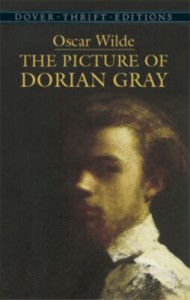The Picture of Dorian Gray
 What does evil do to a soul? And how would you live if the only marks it left were preserved visibly in a secret work of art? Apparently for Oscar Wilde in The Picture of Dorian Gray, the answer is, “as decadently as possible.” The story’s vapid pretty-boy protagonist prays for eternal youth in exchange for a painting that bears all the burden of his soul, then spirals downward through various forms of degeneracy until he finally commits murder and (by accident) suicide.
What does evil do to a soul? And how would you live if the only marks it left were preserved visibly in a secret work of art? Apparently for Oscar Wilde in The Picture of Dorian Gray, the answer is, “as decadently as possible.” The story’s vapid pretty-boy protagonist prays for eternal youth in exchange for a painting that bears all the burden of his soul, then spirals downward through various forms of degeneracy until he finally commits murder and (by accident) suicide.
Reading this brought similar stories to mind. For instance, it takes up the same question as Woody Allen’s movie Crimes and Misdemeanors, which tells the tale of a wealthy optometrist who has his mistress murdered, then lives in terror that he’ll be found out. He believes “the eyes of God are everywhere.” But no one ever catches him, and he lives happily ever after.
Interestingly enough, he has a counterpart in this story: Lord Henry Wotton, a wealthy playboy and esthete who worships superficial, value-free beauty. (In this book there is such a thing.) Moral goodness bores him. He instills this value in young Dorian Gray, who carries it to such an extreme that evil eventually becomes “a mode through which he could realize his conception of the beautiful.”
But while Lord Henry seems comfortable with his decadence, and never suffers any real consequences, Dorian Gray never quite makes his peace with it. Lord Henry knows how to walk the line without losing reputation, and even makes a name for himself as a naughty boy for his witty and heartless epigrams. But Dorian, though his appearance remains youthful and unspoiled, and though he has the advantages of wealth and social standing, develops a reputation as a truly evil man. We don’t get graphic examples of what this means, but we do learn that everyone close to him either commits suicide or grows to despise him. Finally he murders Basil Hallward, the artist who painted his picture in the first place. Then, in trying to destroy the picture, he ends up destroying himself.
Did I enjoy reading this book? Well, as one of my more sophisticated professors used to say, “It has its langeurs.” Translation: it’s got a big dead spot in the middle, full of tedious descriptions of Dorian Gray’s eccentric hobbies and collections. And the experience of reading the book forced me to hang out longer than I ordinarily do with people I don’t like (i.e. this cast of characters). “Wilde was attacked for his decadence and corrupting influence” when the novel was published, reads the flyleaf. “A few years later the book and the aesthetic/moral dilemma it presented became issues in the trials occasioned by Wilde’s homosexual liaisons, trials that resulted in his imprisonment.” Given the story’s severe moral verdict on Dorian Gray, who dies as a result of his sins, it’s ironic that Wilde himself is similarly destroyed by a work of art.


